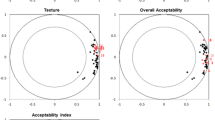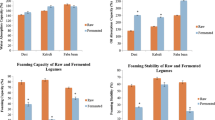Abstract
Studies were conducted to develop an appropriate household/small-scale enterprise level technique for the production of soy-fortified fermented maize dough (or meal) by comparing different treatments, processing methods and fortification levels. The effects of fortification method of the Ghanaian traditional fermented maize dough with raw or heat-treated whole soybeans and full-fat soyflour at 0%, 10% and 20% replacement levels, on the rate of fermentation and product quality were investigated. Sensory characteristics, trypsin inhibitor activity, amino acid pattern, proximate composition and hot paste viscosity were used as the indices of quality. Addition of whole soybeans to maize before milling and fermentation reduced the fermentation time by 60% while increasing the protein content by 24% and 70% respectively for 10% and 20% levels of fortification. A significant improvement was also achieved in the amino acids pattern of the fortified dough. However, raw whole soybeans imparted an undesirable color and beany flavor and an appreciable concentration of trypsin inhibitor activity (TIA) to the dough. Boiling soybeans for 20 min before incorporation into the maize for milling and fermentation was found necessary for desirable flavor and low levels of TIA. Little or no changes in the pasting viscosity characteristics occurred in samples containing boiled soybeans, while the usual method of fortifying maize meal with soy flour was found to severely depress the pasting viscosity characteristics and drastically reduced the acidity of the fermented dough. Based on the findings of the study, the most appropriate technique for the production of soy-fortified high protein fermented maize dough has been suggested to involve incorporation of boiled whole soybeans in soaked maize before milling and fermentation for improved sensory characteristics, enhanced nutritive value and optimal functional properties.
Similar content being viewed by others
References
Dovlo FE (1968) Maize: Its processing and preparation for food in Ghana. Special Report: Food Research Institute, Accra, Ghana.
Plahar WA, Leung HK (1982) Effect of moisture on the development of carboxylic acids in traditional maize dough fermentation. J Sci Food Agric 33: 555-558.
Plahar WA, Leung HK (1983) Composition of Ghanaian fermented maize meal and the effect of soy fortification on sensory properties. J Sci Food Agric 34: 407-411.
Christian WFK (1967) Fermented foods of Ghana. F.R.I. Project Report. Food Research Institute, Accra, Ghana.
Muller HG (1970) Traditional cereal processing in Nigeria and Ghana. Ghana J Agric Sci 3: 187-191.
Akinrele IA (1970) Fermentation studies on maize during the preparation of a traditional African starch-cake food. J Sci Food Agric 21: 619-625.
Bediako-Amoah B, Muller HG (1976) Studies on Kenkey with particular reference to calcium and phytic acid. Cereal Chem 53: 365-375.
Banigo EOI, Muller HG (1972) Carboxylic acid patterns in Ogi fermentation. J Sci Food Agric 23: 101-111.
Plahar WA, Leung HK, Coon CN (1983) Effects of dehydration and soy fortification on physicochemical, nutritional and sensory properties of Ghanaian fermented maize meal. J Food Sci 48: 1255-1259.
Banigo EOI, DeMan JM, Duitschaever CL (1974) Utilization of high-lysine corn for the manufacture of Ogi using a new, improved processing system. Cereal Chem 51: 559-572.
Adeniji AO, Potter NN (1978) Properties of Ogi powders made from normal, fortified and opaque-2 corn. J Food Sci 43: 1571-1575.
Ekpenyong TE, Babatunde LF, Oyenuga VA (1977) Fortification of maize flour based diets with blends of cashew nut meal, African locust bean and sesame oil meal. J Sci Food Agric 28: 710-716.
Halm M, Osei-Yaw A, Hayford A, Kpodo KA, Amoa-Awua WKA (1996) Experiences with the use of starter culture in the fermentation of maize for ‘kenkey’ production in Ghana. World J Micro Biotech 12(5): 531-536.
AACC (1983) Approved Methods. St Paul, MN: American Association of Cereal Chemists.
Shuey WC, Tipples KH (1982) The amylograph handbook. St Paul, MN: American Association of Cereal Chemists.
AOAC (1984) Official Methods of Analysis. Washington, DC: Association of Official Analytical Chemists.
Hirs CHW(1967) Determination of cystine as cysteic acid. Methods in enzymology 11: 59-62.
Opienska-Blauth Jr, Charrzinski M, Merbec H (1963) A new rapid method of determining tryptophan. Anal Biochem 6: 69-76.
Johnson JM, Flick GJ, Long KA, Phillips JA (1988) Menhaden (Brevoortia tyrannus): Thermally processed for a potential food resource. J Food Sci 53: 323-324.
Larmond E (1977) Laboratory Methods for Sensory Evaluation of Foods. Canada: Department of Agriculture Publication 1937.
Hammerstrand GE, Black LT, Glover JD. (1981) Trypsin inhibitors in soy products: modification of the standard analytical procedure. Cereal Chem 58(1): 42-45.
Plahar WA, Annan NT (1994) Development of balanced protein-energy weaning foods based on local legumes and cereals. Report submitted to the Association of African Universities. Accra, Ghana: Food Research Institute, 1994.
FAO/WHO/UNU (1985) Energy and protein requirements. Report of a joint FAO/WHO/UNU Expert Consultation. Geneva: WHO, Technical Report Series, No.724: 113-130.
Author information
Authors and Affiliations
Rights and permissions
About this article
Cite this article
Plahar, W.A., Nti, C.A. & Annan, N.T. Effect of soy-fortification method on the fermentation characteristics and nutritional quality of fermented maize meal. Plant Foods Hum Nutr 51, 365–380 (1997). https://doi.org/10.1023/A:1007996203309
Issue Date:
DOI: https://doi.org/10.1023/A:1007996203309




